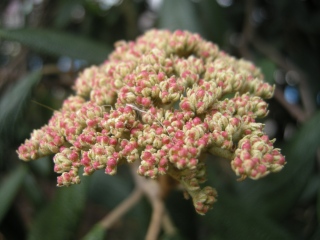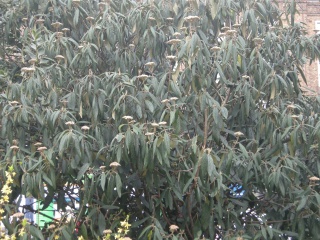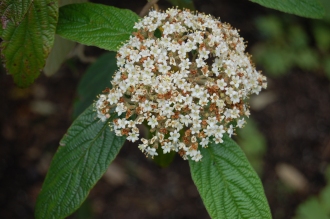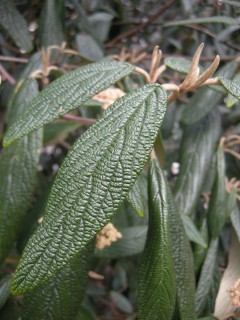Position: Full sun to dappled shade
Flowering period: Spring to summer
Soil: Moist, well drained
Eventual Height: 4m
Eventual Spread: 5m
Hardiness: 5a, 5b, 6a, 6b, 7a, 7b, 8a, 8b, 9a
Family: Adoxaceae
Viburnum rhytidophyllum is a fast growing, medium sized evergreen shrub. Its glossy dark green leaves are opposite, lanceolate with entire margins, have downy undersides, are deeply veined and are up to 20cm long and 6cm broad. Its young brown stems are also downy. Its flower buds are pink, these develop into creamy white flowers which are tubular and up to 5mm across. These bloom in clusters with a domed habit. Its fruit is an attractive red berry, which turns a shiny black when mature.
Viburnum rhytidophyllum, commonly known as Leatherleaf Arrowwood, Wrinkled Viburnum or Leatherleaf Viburnum, is native to central and western China. It was introduced into the UK by Ernest Wilson in 1900. Viburnum rhytidophyllum is beginning to become naturalised in the UK as its seed is spread by birds.
The etymological root of the binomial name Viburnum is derived from the classical Latin name for Wayfaring tree, Viburnum lantana. Rhytidophyllum is derived from the Greek rutido ‘wrinkled’ and fullon ‘leaf”.
The landscape architect may find Viburnum rhytidophyllum useful as a medium sized evergreen shrub, with large distinctive leaves and spring flowers, particularly in shady locations. It may also be used as an informal hedging plant. It’s tolerance of urban pollution and once established this plant is drought tolerant.
Ecologically, Viburnum rhytidophyllum is attractive to bees and butterflies.
Viburnum rhytidophyllum prefers moist, moderately fertile, well-drained soils. It tolerates most pH of soil. It will also tolerate chalky soils.
Viburnum rhytidophyllum requires little maintenance. Any formative pruning should be carried out in the summer, after flowering.









Leave a comment